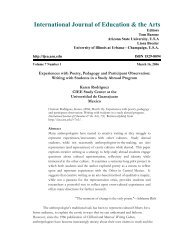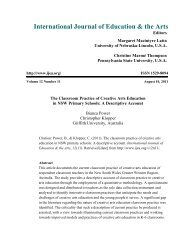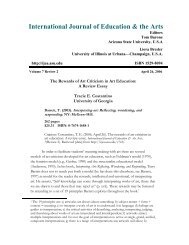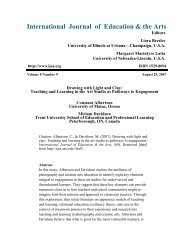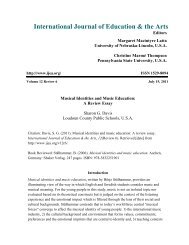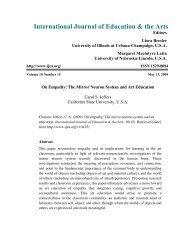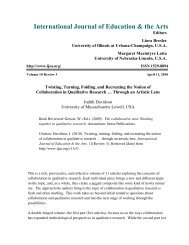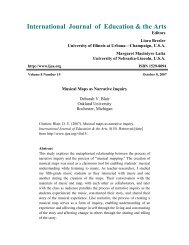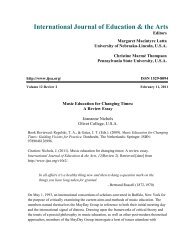Creating a self: A narrative and holistic perspective
Creating a self: A narrative and holistic perspective
Creating a self: A narrative and holistic perspective
You also want an ePaper? Increase the reach of your titles
YUMPU automatically turns print PDFs into web optimized ePapers that Google loves.
IJEA Vol. 8 No. 13 – http://www.ijea.org 22experience, <strong>and</strong> enable them to envision <strong>and</strong> enact social change. They value this level ofautonomy, responsibility, <strong>and</strong> spontaneity. The ongoing work of creating <strong>and</strong> re-creatinga learning community such as this resembles the work of creating a good home(Noddings, 2003). Building on the work of Jane Rol<strong>and</strong> Martin (1992), Noddings (2003)explains:The best schools should resemble the best homes. . . . The best homes providecontinuity of caring relations, attend to <strong>and</strong> continuously evaluate both inferred<strong>and</strong> expressed needs, protect from harm without deliberately inflicting pain,communicate so as to develop common <strong>and</strong> individual interests, work togethercooperatively, promote joy in genuine learning, guide moral <strong>and</strong> spiritualdevelopment (including the development of an uneasy conscience), contribute tothe appreciation of the arts <strong>and</strong> other cultural achievements, encourage love ofplace <strong>and</strong> protection of the natural world, <strong>and</strong> educate for both <strong>self</strong>-underst<strong>and</strong>ing<strong>and</strong> group underst<strong>and</strong>ing. (pp. 260-261)Phillipa <strong>and</strong> Eva tell of the importance of engaging their hearts, emotions, <strong>and</strong>imaginations as well as their intellects, in order to help them to express, explore, <strong>and</strong>transcend the limits of their past experiences, their familial, cultural <strong>and</strong> socialconditioning, <strong>and</strong> to transform the <strong>narrative</strong>s that they can tell <strong>and</strong> enact in their lives.Their words can help us to underst<strong>and</strong> the ways in which we can create the kinds ofrelationships <strong>and</strong> learning communities which can be felt at many levels of awareness bystudents, where they can be openly reflective about their experiences <strong>and</strong> can collaboratewith colleagues <strong>and</strong> teachers to connect memory <strong>and</strong> imagination, <strong>and</strong> to create new<strong>narrative</strong>s for their future lives.It is in the backward motion towards the sourceAgainst the stream, that most we see ourselves inThe tribute of the current to the sourceIt is this in nature we are fromIt is most us.(Robert Frost, 1950, “West Running Brook”, p. 329)ReferencesBahktin, M. (1986). Speech genres <strong>and</strong> other late essays. Austin: University of TexasPress.Bateson, M. C. (1989). Composing a life. New York: The Atlantic Monthly Press.




